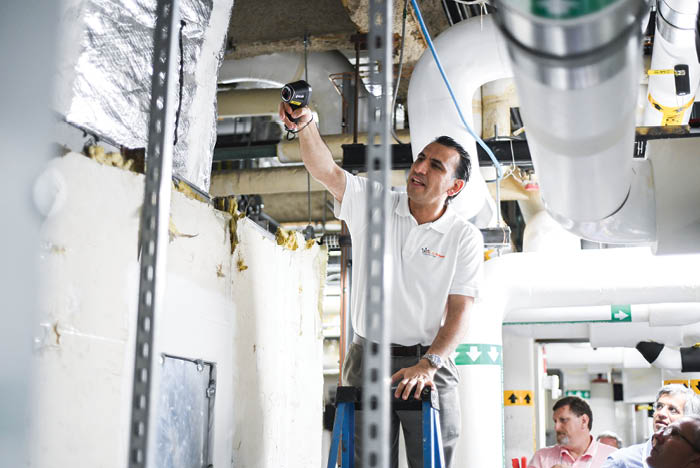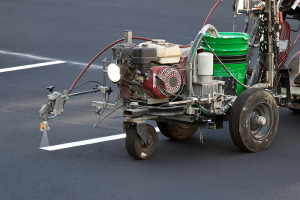HealQuest helps hospital staff save money — and the planet

The HealQuestTM program builds upon previous Energy to Care® Treasure Hunts, such as one hosted by the University of Maryland Medical Center pictured above, where participants identified potential savings opportunities.
Image courtesy of ASHE
Hospitals around the country are working to reduce their environmental impact in response to tightening sustainability regulations as well as grassroots calls to action from staff and leadership. But knowing where to start a sustainability effort — or how to leverage it into operational cost-savings — can be difficult. The Joint Commission recently announced it will launch a voluntary certification program in January 2024 to help hospitals accelerate their sustainability initiatives and reduce carbon emissions. As sustainability continues to build momentum in the health care space, so will the need for tools and resources to guide hospitals along their sustainability journeys.
The new HealQuestTM program from the American Society for Health Care Engineering (ASHE) does just that by training interdepartmental teams of hospital staff members on the importance of sustainability and accountability, as well as how to identify hidden cost-saving opportunities within a facility.
HealQuest stems from ASHE’s Energy to Care® Treasure Hunt Program, which brought together health care facilities professionals to find low-cost operational energy savings opportunities within their clinical sites. Teams of facility managers searched through the hospital and found a range of potential projects that increase efficiency and save money, garnering resources that can be reinvested in patient care.
Hospitals that participated in the Treasure Hunt Program, on average, identified $900,000 in savings per year. The University of Maryland Medical Center (UMMC) in Baltimore, for example, found numerous no-cost opportunities that totaled approximately $552,000. When adding in projects that did require an initial investment, UMMC found over $2 million in total savings opportunities.
The COVID-19 pandemic halted ASHE’s ability to conduct Treasure Hunts Programs in hospitals but provided the chance to redesign and improve the program, which eventually became HealQuest. Key takeaways from the Treasure Hunts that have been incorporated into the HealQuest program include a focus on team building and creating culture shift around sustainability and operational efficiency. HealQuest broadened the Treasure Hunts to focus on all facets of sustainability that impact health care — including energy, water, material waste and personal staff choices, like deciding to turn off the lights in a storage room.
The individual actions of staff have a huge impact on resource use in a health care facility. Expanding HealQuest training to include all hospital staff boosts accountability across the organization and can create friendly competition between departments as they work to save resources. The program can serve as an effective start to sustainability efforts that cascade throughout a health care facility.
HealQuest employs a four-tiered learning approach that allows participants, regardless of prior knowledge and experience, to gain a foundational understanding of sustainability and decarbonization. In the first tier, participants begin by enrolling in Operation Decarbonization, a self-paced, asynchronous e-learning course. Participants learn how to build a cross-functional team that works collaboratively to achieve sustainability goals in their health care facility, establish a project-specific action plan to make progress on sustainability initiatives, construct a compelling business case to support decision-making and buy-in from hospital leadership, and develop a strategy to approach decarbonization and other sustainability targets.
The second tier of HealQuest consists of on-site, multidisciplinary team trainings led by ASHE staff. In Tier 2, participants discuss sustainability concepts like the environment, population health and the economy and their applications in health care. Sustainability is a broad concept encompassing many aspects. For example, sustainability to some can mean a focus on conserving energy or water. Others might promote positive health and equity within their communities, or define sustainability by being conscientious about the levers or constraints for resources needed to execute a business plan or project.
Tier 2 enables participants to uncover their own individual priorities when it comes to sustainability by identifying the motives that intrinsically drive individual attitudes around sustainability at their facility. Hospital sustainability teams can diversify their constituent roles, and filling a team with individuals who possess each of these unique motivators ensures a well-rounded and successful effort.
Following the team trainings, HealQuest participants move into the third tier, which involves exploring the hospital site for savings opportunities. Participants are broken into teams based on their sustainability priorities and hospital departments to guarantee that a variety of perspectives are represented in each facility area as the teams explore. Each team leader is provided a tablet preloaded with a Sustainability Calculator Tool that highlights each search area, including intensive care unit/postoperative, patient rooms, storage areas, mechanical room or central plant.
The Sustainability Calculator Tool offers questions that help direct participants’ attention as they enter a space, prompting them to make observations and assessments of existing systems like lighting, building envelope, water and ventilation. For example, a team may find small leaks in the seal of air-handling units. Using the Sustainability Calculator Tool as a guide, participants can ensure that no stone is left unturned and all sustainability impacts are recorded.
Once each team has completed its search, all teams regroup to evaluate their findings and calculate the estimated annual savings for each identified opportunity using provided formulas and equations, as well as their own team knowledge. At the end of Tier 3, each team is left with a list of savings opportunities that is compiled and prioritized based on cost, duration of implementation and return on investment. This list can then be given to the hospital sustainability representative or team to share with executive leadership.
In the fourth tier of HealQuest, participants develop a plan to act on each savings opportunity. Tier 4 includes one year of sustainability consultation and guidance from HealQuest staff at a facility, including regular check-in meetings that aid facilities in mobilizing their sustainability teams. HealQuest also helps hospitals address obstacles they encounter, establish a sustainability improvement baseline and measure progress, locate funding opportunities and engage with stakeholders. ASHE has extensive knowledge and resources, and HealQuest’s Tier 4 connects health facilities with the most beneficial and applicable tools for them to achieve their sustainability initiatives.
Three essential goals that HealQuest sets out to accomplish are:
- Bring teams together with an interdisciplinary approach to create a sustainability-minded culture in a hospital.
- Engage cross-functional teams and executive leadership within a mission-driven organization.
- Rediscover revenue that can be reinvested into critical hospital operations like patient care.
Whether a health care facility is just starting out in its sustainability work or years along, staff is the driving factor that carries on the mission. HealQuest is a valuable tool that ensures those who share the hospital space are prepared and engaged with sustainability and resource accountability.
For more information about HealQuest or to host a program, please contact Austin Wallace, M.A., ASHE senior sustainability specialist, at awallace@aha.org.



